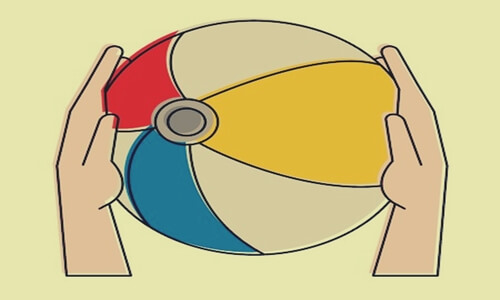The Beach Ball Metaphor for Emotional Regulation


Written and verified by the psychologist Valeria Sabater
The beach ball metaphor is very useful for regulating emotions, especially anxiety. It’s a visualization strategy that also involves a bit of creativity. This is because everyone deals with things differently, and this exercise highlights that fact.
To evaluate the relevance of these tools for the practicing psychologist, it’s important to first understand what we mean by “therapeutic metaphors”. They’re a series of stories or rhetorical situations that allow patients to discover a relationship between the beginning concept and some kind of related personal reality.
One of the most famous therapeutic metaphors is the quicksand metaphor. Its goal is to help patients understand that, sometimes, the more you fight a problem, the further you’ll sink. Oftentimes, the solution lies in facing whatever it is you’ve been avoiding.
These kinds of thought exercises require a series of psychological processes that are very helpful during the therapeutic process. Firstly, the patient has to understand the metaphor. Then, they have to identify with it. After that, they establish a connection between what the metaphor is explaining and what’s happening to them. Last but not least, the patient has to think of a strategy that will help them in their personal lives based on the metaphor the psychologist presented.
The psychologist should assume the role of facilitator and let the patient solve the challenge presented by the exercise.

What’s the beach ball metaphor?
For the beach ball metaphor to be effective, it’s a good idea to talk about visualization. As psychologists McCurry and Hayes explained in their study “Clinical and experimental perspectives on metaphorical talk“, creating mental images helps patients recall metaphors later on. That way, they can use them whenever they need them.
Let’s see what this exercise is all about.
In your mind, visualize the following situation…
You’re on the beach. It’s a perfect sunny day. Every part of this perfect scene is saturated with light. However, you don’t feel well. You’re anxious and your emotions are all over the place. They’re jumbled together, swirling around in an almost painful way. You feel scared, ashamed, anxious, and angry.
- The entirety of this emotional universe is contained in a beach ball. This object symbolizes all the emotions you’re feeling. They’re bothering you so much that all you want to do is get rid of them. So what do you do? You walk out on the beach and try to sink the ball.
- Visualize this scenario in detail. Imagine yourself trying to sink that beach ball. You don’t want anyone to see or notice it. You just want to make it disappear forever. You’d like the ocean current to sweep it away, never to be seen again. But every time you push it under, it pops up to the surface again. In fact, the more you try to sink it, the harder it pops back up. It might even hit you on its way back out of the water and knock you off balance.
How can you solve this problem?
The next step in the metaphor requires a bit of effort. As we mentioned at the beginning of the article, you need a little bit of creativity for this part of the exercise. To be able to come up with a better solution, keep these factors in mind:
- The ball symbolizes your emotions, anxiety, fear, anger, and shame, which you’ve been hiding for some time. However, you’re aware of the consequences of keeping them bottled up inside.
- So what solution would you offer to this metaphorical dilemma?

The most appropriate response is to stop trying to sink the ball. Stop wasting your energy on an impossible and unhealthy task. Hiding your emotions simply doesn’t work. Trying to force them down only enhances the problem.
Instead, take the ball, sit calmly on the beach, and deflate it. Let all the air out. Once you do that, you’ll feel so much better. You’ll feel relieved. However, to do that, you need to know where the valve is.
Here, the beach ball metaphor helps each individual find their unique strategy to get rid of their anxiety, fear, and shame. Finding the “mechanism” that helps you understand why you feel the way you feel will make it easier to free yourself from those emotions.
Although this isn’t easy, this metaphor serves to remind you that trying to bottle up your emotions is like trying to keep a beach ball underwater. It simply doesn’t work. The healthy approach, instead, is accepting, understanding, and letting go of your emotions.
The beach ball metaphor is very useful for regulating emotions, especially anxiety. It’s a visualization strategy that also involves a bit of creativity. This is because everyone deals with things differently, and this exercise highlights that fact.
To evaluate the relevance of these tools for the practicing psychologist, it’s important to first understand what we mean by “therapeutic metaphors”. They’re a series of stories or rhetorical situations that allow patients to discover a relationship between the beginning concept and some kind of related personal reality.
One of the most famous therapeutic metaphors is the quicksand metaphor. Its goal is to help patients understand that, sometimes, the more you fight a problem, the further you’ll sink. Oftentimes, the solution lies in facing whatever it is you’ve been avoiding.
These kinds of thought exercises require a series of psychological processes that are very helpful during the therapeutic process. Firstly, the patient has to understand the metaphor. Then, they have to identify with it. After that, they establish a connection between what the metaphor is explaining and what’s happening to them. Last but not least, the patient has to think of a strategy that will help them in their personal lives based on the metaphor the psychologist presented.
The psychologist should assume the role of facilitator and let the patient solve the challenge presented by the exercise.

What’s the beach ball metaphor?
For the beach ball metaphor to be effective, it’s a good idea to talk about visualization. As psychologists McCurry and Hayes explained in their study “Clinical and experimental perspectives on metaphorical talk“, creating mental images helps patients recall metaphors later on. That way, they can use them whenever they need them.
Let’s see what this exercise is all about.
In your mind, visualize the following situation…
You’re on the beach. It’s a perfect sunny day. Every part of this perfect scene is saturated with light. However, you don’t feel well. You’re anxious and your emotions are all over the place. They’re jumbled together, swirling around in an almost painful way. You feel scared, ashamed, anxious, and angry.
- The entirety of this emotional universe is contained in a beach ball. This object symbolizes all the emotions you’re feeling. They’re bothering you so much that all you want to do is get rid of them. So what do you do? You walk out on the beach and try to sink the ball.
- Visualize this scenario in detail. Imagine yourself trying to sink that beach ball. You don’t want anyone to see or notice it. You just want to make it disappear forever. You’d like the ocean current to sweep it away, never to be seen again. But every time you push it under, it pops up to the surface again. In fact, the more you try to sink it, the harder it pops back up. It might even hit you on its way back out of the water and knock you off balance.
How can you solve this problem?
The next step in the metaphor requires a bit of effort. As we mentioned at the beginning of the article, you need a little bit of creativity for this part of the exercise. To be able to come up with a better solution, keep these factors in mind:
- The ball symbolizes your emotions, anxiety, fear, anger, and shame, which you’ve been hiding for some time. However, you’re aware of the consequences of keeping them bottled up inside.
- So what solution would you offer to this metaphorical dilemma?

The most appropriate response is to stop trying to sink the ball. Stop wasting your energy on an impossible and unhealthy task. Hiding your emotions simply doesn’t work. Trying to force them down only enhances the problem.
Instead, take the ball, sit calmly on the beach, and deflate it. Let all the air out. Once you do that, you’ll feel so much better. You’ll feel relieved. However, to do that, you need to know where the valve is.
Here, the beach ball metaphor helps each individual find their unique strategy to get rid of their anxiety, fear, and shame. Finding the “mechanism” that helps you understand why you feel the way you feel will make it easier to free yourself from those emotions.
Although this isn’t easy, this metaphor serves to remind you that trying to bottle up your emotions is like trying to keep a beach ball underwater. It simply doesn’t work. The healthy approach, instead, is accepting, understanding, and letting go of your emotions.
All cited sources were thoroughly reviewed by our team to ensure their quality, reliability, currency, and validity. The bibliography of this article was considered reliable and of academic or scientific accuracy.
- McCurry, S., & Hayes, S. C. (1992). Clinical and experimental perspectives on metaphorical talk. Clinical Psychology Review, 12, 763-785.
This text is provided for informational purposes only and does not replace consultation with a professional. If in doubt, consult your specialist.







